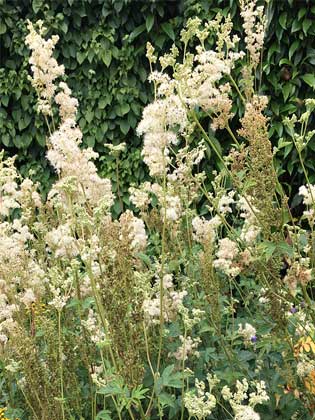
- Herb
- Bees and butterflies
- Medicinal
Meadowsweet
Filipendula ulmaria
A medicinal meadow herb with a froth of creamy sweet smelling flowers in Summer.
PLANT TYPE Herb
PLANT HABIT Perennial
USES Medicinal, Pollinators, Ornamental
DESCRIPTION
From June to September Meadowsweet blooms a ‘froth’ of sweet vanilla/almond smelling creamy-white flowers, that sit on erect stems. It has dark green leaves are divided into pairs of leaflets and have silvery undersides.
Meadowsweet has painkilling and anti-inflammatory properties thanks to compounds similar to aspirin. Flowering tops and leaves can be harvested in summer. Dried leaves can be used as a tincture, herbal tea or to sweeten other teas. There may be nothing closer to real magic than a tea of dried Meadowsweet flower, with homemade oat milk and black bee comb honey on a dark stormy winter’s night.
Traditionally was used as a strewing herb, strewn on floors to give the rooms a pleasant aroma, and its use to flavour wine, beer, and many kinds of vinegar. The flowers can be added to stewed fruit and jams, giving them a subtle almond flavour.
Meadowsweet is the food plant for the larvae of several moth species including the emperor moth, grey pug, Hebrew character, lime-speck pug, mottled beauty, and the satellite. Many species of insects are attracted to the flowers.
Also known as Queen of the meadow, Pride of the meadow, Meadow-wort, Meadow queen, Lady of the meadow, Dollof, Meadsweet, and Bridewort.
RECOMMENDED LOCATION , Forest garden, Wildlife garden, Ornamental garden
Aspect , Full sun, Moist shade, Moist partial shade, Moist full sun
Height 1.2m
Spread 0.5m
Hardiness Hardy in UK WInter
Origin/history
In the wild, grows in damp meadows and boggy areas, ditches and river banks.
Queen Elizabeth I adorned her apartments with meadowsweet. The flowers were used to flavour alcoholic beverages in England and Scandinavian countries. In the Middle Ages, meadowsweet was known as “meadwort” because it was used to flavor mead, an alcoholic drink made by fermenting honey and fruit juices.
In 1838 an Italian professor, Rafaele Piria, produced salicylic acid from the flower buds of Meadowsweet. In 1897 Felix Hoffmann, working for the German drug company Bayer, synthesised salicin based on the study of meadowsweet which was better tolerated by the stomach lining. Bayer named the new drug aspirin, derived from an old botanical name for meadowsweet: Spiraea ulmaria.
